The heart’s ejection fraction refers to the percentage of blood pumped out of each ventricle in one beat. Ejection fraction can be measured either with an echocardiogram or cardiac MRI, and it’s one of the most important measures of your heart’s health and function. But as much as we cardiologists like to talk about this number, we are well aware that it doesn’t tell the whole story.
An ejection fraction, often abbreviated EF, is one of the most critical values used in cardiology to assess heart function. The EF is expressed as a percentage. For example, Normal EF is around 55 percent, which means that each beat pumps out 55 percent of the total blood volume in the heart. And, 45% was not ejected and remained in the left ventricle following each heartbeat. Similarly, if an individual has an EF of 30%, it means that per beat, 40% of their heart’s total blood volume was pumped out. Therefore, 70% was not ejected and remained in the left ventricle following each heartbeat.
How to calculate ejection fraction?
Ejection fraction is the quantity of blood that leaves the heart in one contraction (divided by the total blood in the ventricles before they contract (End diastolic volume or EDV).
The quantity of blood that leaves the heart in one contraction is called stroke volume
The amount of the blood in the ventricles that remains in the heart after they contract is the end-systolic volume or ESV.
Stroke volume= EDV-ESV
Ejection fraction = Stroke volume/ EDV multiplied by 100
Ejection fraction =EDV-ESV/EDV multiplied by 100

Tests to calculate ejection fraction are
- Nuclear medicine scan (multiple gated acquisition MUGA]) of the heart
- Cardiac catheterization
- Nuclear stress test
- 2d echo test-more popular
- Cardiac MRI-more accurate

Ejection fraction can be calculated for the left ventricle and the right ventricle as well.
Left ventricular ejection fraction (LVEF)
The ejection fraction, by default, is the left ventricular ejection fraction only. The left ventricle is the left-sided lower chamber of the heart that supplies the whole body except the lungs.
Right ventricular ejection fraction (RVEF)
The right ventricle is the right-sided lower chamber of the heart that supplies the lungs. 2d echo can not calculate Right ventricular ejection fraction (RVEF). Either a 3d echo, cardiac MRI, or MUGA scan is needed to calculate RVEF. A different parameter assesses right ventricular function in 2d echo. That’s called TPSE.
Cardiac MRI accurately calculates EDV and ESV when compared to a 2d echocardiogram. 3d echo is better than 2d echo for determining the ejection fraction. Therefore, Cardiac MRI is the gold standard for assessing ejection fraction.
However, 2d echo still remains the initial test for calculating ejection fraction as it is widely available, inexpensive, and simple to perform.
Importance of an ejection fraction or EF?
An ejection fraction is one of several measures of how efficiently your heart pumps blood, and it’s an essential gauge for your health. Ejection fraction refers to how much blood your left ventricle pumps out with each contraction. In other words, it measures how much of your blood gets pumped back into circulation versus staying in your heart. Ejection fraction can help diagnose heart failure. A low EF means your heart is weak.
How do we measure an ejection fraction in the 2d echo test?
The most common way we measure ejection fraction is through 2D echo or M-mode echocardiography. In 2D echo, you can get left ventricular (LV) ejection fraction measurements by assessing the left ventricle’s systolic and diastolic dimensions in parasternal long views of your heart. Once you have that, the machine automatically calculates the ejection fraction based on a predetermined algorithm.
Systole: The contraction of your heart when it squeezes blood into circulation.
Diastole: The relaxation of your heart when it receives the blood from the circulation.
Ejection fraction classification
Ejection fraction normal range
An average normal ejection fraction is about 50% to 75%. That means your heart can pump 50 to 75 % of the blood in the ventricles with each contraction.
High ejection fraction
A high ejection fraction is defined as an ejection fraction greater than 70% to 75%.
A high ejection fraction is seen in
- HOCM or hypertrophic cardiomyopathy
- Mitral regurgitation
HCM (hypertrophic cardiomyopathy) is a condition in which the heart muscle thickens abnormally (hypertrophied). The heart’s swollen muscle can make it more challenging to pump blood. HOCM is a common cause of sudden death in the young.
Mitral valve regurgitation is a kind of heart valve illness in which the valve connecting the two chambers of the left heart does not close completely, causing blood to seep backward across the valve.
Borderline ejection fraction
A 41 to 49 percent ejection fraction may be considered “borderline.” Mid-range is another term for it.
Low ejection fraction
EF less than 40 % is regarded as a low ejection fraction. Less than 30% is considered a severe low ejection fraction.
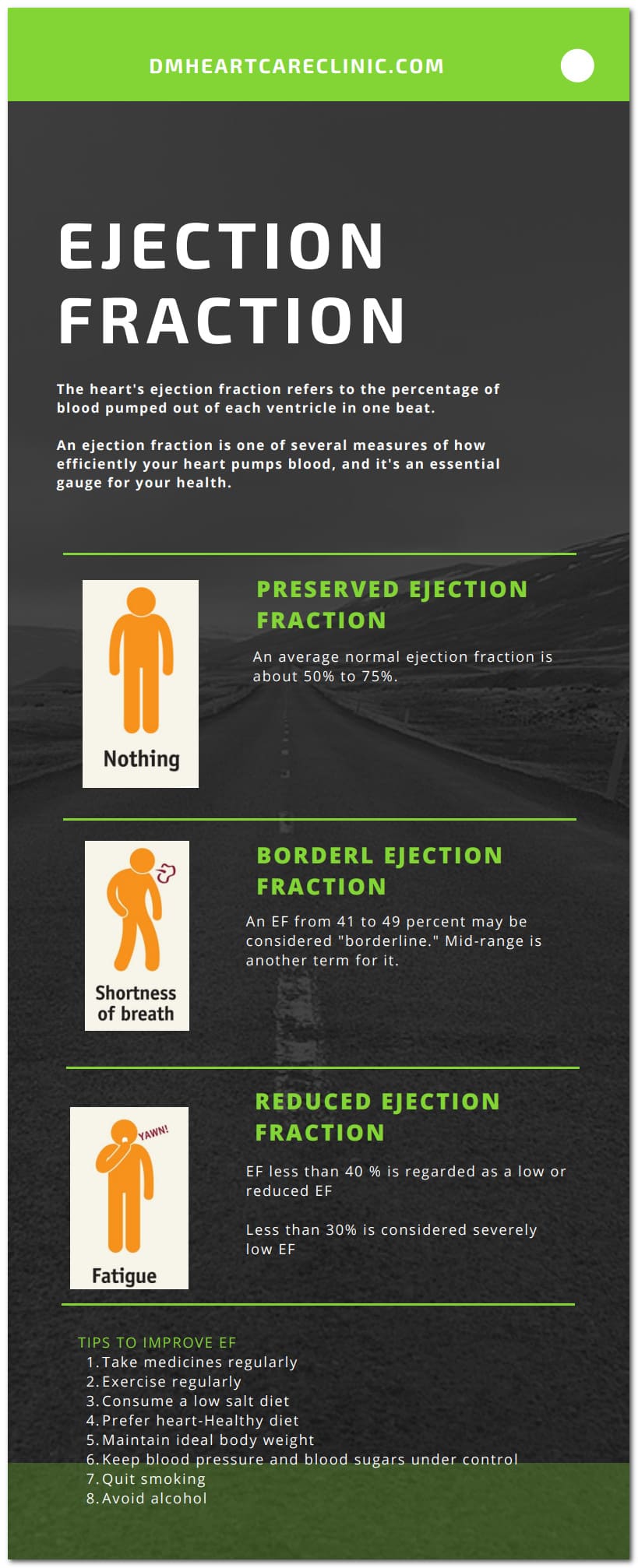
What is a dangerously low ejection fraction of the heart in an echocardiogram?
In general, the lower the number, the higher the complications. However, few people with average or near-normal ejection fraction can have early Death from heart disease compared to those with low ejection fraction. Ejection fraction is just one of the parameters that determine your heart function and health, among many. Other parameters like age, cause of the low ef, the severity of the symptoms, response to medicines, levels of NT pro-BNP, and presence of other diseases like diabetes, kidney disease, liver diseases, and lung diseases. Anything less than 30% is considered a dangerously low ejection fraction.
What causes someone to have an abnormal ejection fraction?
Many things can cause someone to have an abnormal ejection fraction. Things like old age, high blood pressure, coronary artery disease, and valvular defects are just some of them. To be honest, though, if you want to know l what causes your problem, you’ll need to see your heart doctor or cardiologist.
The causes of low ejection fraction in 2d echo test are
- No Known cause or idiopathic
- Coronary artery disease or CAD
- Heart attack
- Myocarditis
- Hypertension or high blood pressure
- Faulty valves of the heart like abnormal leakage of the valve or obstruction of the valve
- HIV or human immunodeficiency virus or AIDS
- Pregnancy (postpartum cardiomyopathy)
- Genetic
- Drugs
- Toxins
- Connective tissue diseases
-
-
-
- Rheumatoid arthritis (RA)
- Marfan syndrome.
- SLE
-
-
- Congenital heart disease ( the heart disease you are being born with)
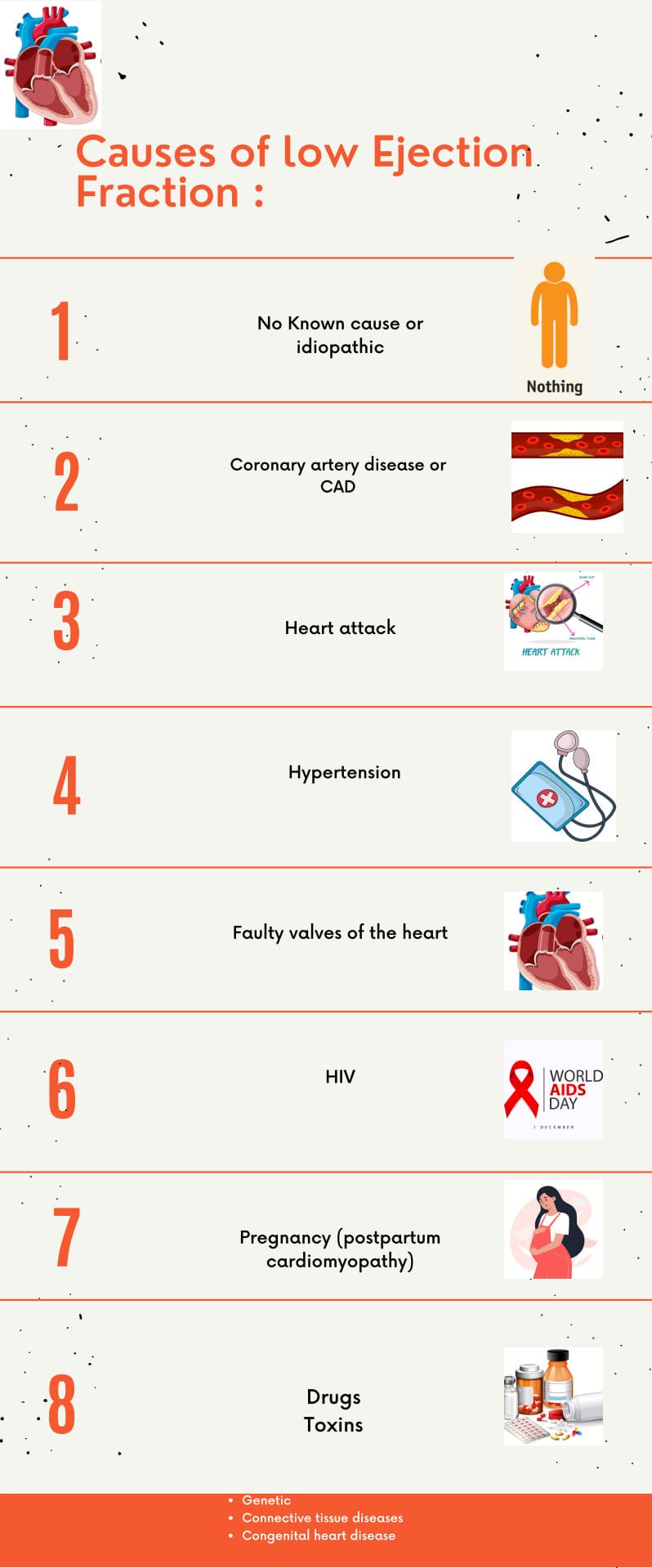
Coronary artery disease
Plaque buildup in the walls of the arteries (called coronary arteries) that deliver blood to the heart causes coronary artery disease. This is the second most common cause for low EF.
Aortic stenosis
Aortic stenosis is one of several types of valvular heart disease, in which your heart valves don’t open properly. It gets narrowed. Untreated aortic stenosis can lead to low ejection fraction.
Aortic regurgitation
Aortic regurgitation is one of several types of valvular heart disease. Your aortic valves don’t close properly and allow blood to leak from the aorta to the left ventricle. Aortic regurgitation, if untreated, causes reduced ejection fraction.
Mitral regurgitation
Here mitral valve, which lies between the left atrium and the left ventricle, does not close properly. It allows blood to leak from the left ventricle to the left atrium, which does not usually occur. Advanced stages of Mitral regurgitation can make your EF or ejection fraction low.
Myocarditis
Myocarditis is a heart muscle inflammation (myocardium). Inflammation can impair the heart’s ability to pump blood. Myocarditis is mainly caused by a virus infection. It can cause fast or irregular heartbeats (arrhythmias).
How common is the low ejection fraction in the 2d echo test?
Low ejection fraction in a 2d echo test is quite frequent, with more than 1% of the population over 50 years old suffering from it. The prevalence of low ejection fraction rises with age. It affects 6% of the population over the age of 80.
Increased prevalence of low ejection fraction in recent times
- Aging of the population
- Improved treatment for heart diseases allows patients to survive the Death but leads to landing in low ejection fractions in the future
Who should be concerned about their ejection fraction or EF?
The ejection fraction can determine how well your heart pumps blood out of your ventricles. Most people with normal ejection fractions don’t need to worry about their ejection fraction if they have no symptoms. Suppose you do fall into the low ejection fraction category. In that case, however, you must pay close attention to ejection fraction levels. Anyone with a low ejection fraction (EF) should consult a cardiologist.
How can we improve our ejection fraction?
Low ejection fraction is a chronic problem. There is a cure only for a few patients. Chances of having a normal ejection fraction or EF after having low EF depend on the cause of the low ejection fraction. If alcohol or pregnancy are the causes of low ejection fraction, chances of recovery are higher. Postpartum cardiomyopathy or alcohol cardiomyopathy may recover fully.
Ways to prevent low ejection fraction in 2d echo test
- Regular exercise
- Take a Healthy diet
- Avoid smoking
- Stop alcohol
- Maintain a healthy weight
- Moderate alcohol intake
- Regular health check-ups
If you adhere to all the above measures, your lifetime risk of having a low ejection fraction in the 2d echo test reduces.
Apart from controlling sugar levels, Taking certain drugs like SGLT-2 inhibitors for diabetes reduces the risk of low ejection fraction in them
similarly, along with blood pressure control, medicines such as diuretics lessen the chances of having low ejection fraction in the future.
Tips to improve ejection fraction Take medicines regularly
- Exercise regularly
- Consume a low salt diet
- Prefer heart-Healthy diet
- Maintain ideal body weight
- Keep blood pressure and blood sugars under control
- Quit smoking
- Avoid alcohol
Drugs to improve ejection fraction and prolong your life are
Most of these drugs decrease your blood pressure and make it easier for the heart to work
Ace Inhibitors
ACE inhibitors or Angiotensin-converting enzyme (ACE) inhibitors can also treat high blood pressure and low ejection fraction. They improve symptoms and survival chances in many large trials conducted on low ejection fraction patients.
E.g. Enalapril, Ramipril and Captopril
ARBS
ARB or Angiotensin receptor blockers (ARBs) are other drugs to treat high blood pressure and low ejection fraction. They are equally effective as ACE inhibitors. But both drugs should not be combined.
E.g.Valsartan and Candesartan
ARNI
Angiotensin Receptor-Neprilysin Inhibitor (ARNi) is a medicine resulting from combining two drugs. One among them is an Angiotensin receptor blocker (ARBs). They are more effective at improving ejection fraction when compared to ACE inhibitors.
Mineralocorticosteroid Receptor Blockers
They are a type of diuretics and will increase your urine output and reduce blood pressure. They have long-term benefits in low ejection fraction patients on top of ACE inhibitors or ARB or ARNI. They prolong your life.
Spironolactone and eplerenone are an example. These are currently used to treat high blood pressure and low ejection fraction.
Beta-Blockers
Beta-blockers work by blocking the effects of the sympathetic system on the heart and blood vessels. They protect the heart from the dangerous impact of hormones like epinephrine. Beta-blockers reduce blood pressure and improve ejection fraction. They reduce mortality and enhance ejection fraction on top of ACE inhibitors, ARB, ARNI, and mineralocorticosteroid receptor blockers.
Metoprolol, Carvedilol, and Bisoprolol are recommended beta-blockers.
SGLT2 Inhibitors
These are diabetes medicine. But SGLT2 Inhibitors have been shown to improve ejection fraction and prolong life.
Heart stent surgery for a low ejection fraction
Heart stent surgery can improve low ejection fraction and prolong life expectancy. It is helpful to those patients with low ejection fraction or EF who have significant blockages in their coronary arteries. Stenting restores the blood flow and improves heart function or ejection fraction. Improvement in ejection fraction takes a few months to appear after stent surgery.
CABG or bypass surgery for a low ejection fraction
Grafts used in CABG reestablish the flow to the weak heart (low ejection fraction). After CABG, the heart starts to receive sufficient blood, and ejection fraction is expected to improve. Patients with a low ejection fraction in the 2d echo test and severe stenosis in the coronary arteries should consider surgery.
CRT devise for a low ejection fraction
A CRT device is a type of pacemaker. CRT stands for cardiac resynchronization therapy. Regular pacemakers have one or two wires. Instead, CRT will have three wires. It sends electrical impulses to both lower chambers of the heart. Thereby it helps them beat together in a more synchronized pattern. A CRT device is helpful in low ejection fraction patients where two lower heart chambers lost their synchrony. Your cardiologist decides on the Loss of synchrony with an ECG.
Implantable cardiac defibrillator for a low ejection fraction
- An implantable cardiac defibrillator is also a type of pacemaker. It sends electrical triggers (shocks) to your heart whenever the heartbeat becomes abnormally high and dangerous (ventricular tachycardia or ventricular fibrillation). It prevents sudden Death in low ejection fraction patients.
When to seek immediate medical care when you have a low ejection fraction?
Rush to the heart hospital if you are a known cause of low ejection fraction and experience the following symptoms all of a sudden
- Severe shortness of breath
- Fainting
- Chest pain for more than 15 minutes
- Swelling of the feet and belly
Call your cardiologist if you notice
- Increased shortness of breath
- Increased swelling of the limb
- Increased cough
- Increase in the weight
- fever
Risks associated with low ejection fraction in 2d echo test are
- Heart failure can set in
- Arrhythmias can occur
- Cardiac Death can happen
- Your kidneys may damage
- You may get a brain stroke
- You may get fluid in the lungs
- You may need to get hospitalized frequently
- Your immunity comes down
- Infections become frequent
Low ejection fraction life expectancy
Mortality per year with a low ejection fraction is almost 19%. Regular intake of medicines for low ejection fraction life expectancy will add about nine years. Life expectancy with low ejection fraction increased overtime recently. The main reason is advancement in the treatment modalities. In general, five-year mortality with a low ejection fraction is almost 50%. But this depends on the cause of low ejection fraction, patient’s age, sex of the patient, and other associated diseases.
Symptoms with low ejection fraction in 2d echo
Only 50% of patients with low ejection fraction will have symptoms. Symptoms can range from mild to severe.
Common Symptoms of low ejection fraction are
- Shortness of breath or dyspnea, or breathing difficulties
- Swelling of the feet
- Cough
- Shortness of breath on lying down
- Swelling of the stomach or abdomen
- Pain abdomen
- Chest pain
- Heart palpitations
- Fatigability or feeling tired quickly
- Weakness, significantly in lower limbs, when exercising
- Dizziness or Lightheadedness
- Weight loss or weight gain
Tests required in low ejection fraction patients
- ECG
- 2d echo
- Renal function test or RFT or KFT
- Liver function test or LFT
- CBC or complete blood picture
- Thyroid profile
- Nt pro-BNP
- HIV
- Blood sugar levels
Depending on their medical history, some patients may require advanced tests like
- Coronary angiogram or CT coronary angiogram
- Cardiac catheterization
- Cardiac MRI or cardiac CT
- Nuclear scans like PET
- Myocardial biopsy
- Genetic test
Supplements to increase ejection fraction
Guidelines do not recommend supplements for heart diseases. Few cardiologists may prescribe the following supplements which can improve ejection fraction (only from anecdotal data)
- Coenzyme q10
- Carnitine
- Omega-3 fatty acids
Foods to improve ejection fraction
Heart failure patients who consume a moderate-fat diet can better manage their condition and improve their quality of life. This diet emphasizes unsaturated fat sources, such as olive oil and nuts, and limits saturated fats found in red meat.
With proper diet and exercise, you can reduce your heart failure symptoms, improve your health and quality of life, reduce your need for medications, and delay or prevent worsening your condition. The Mediterranean diet is effective. This diet emphasizes olive oil as its primary source of fat and fish and nuts instead of red meat. It also limits cheese and sweets. Drinking too much alcohol increases blood pressure (which worsens heart failure) so avoid consuming alcoholic beverages. Keep in mind that talk to your cardiologist before making your diet or lifestyle changes.
Simple ways to remember the diet
- Consume more whole grains
- Include a lot of fruits and vegetables
- Decreases red meat, saturated fat, and simple sugars
- Consume more fish
- reduce the salt intake to less than one spoon for the day
- Avoid junk food, processed food, fried food
Conclusion for ejection fraction
The heart’s ejection fraction refers to the percentage of blood pumped out of each ventricle in one beat. Low heart ejection fraction is a health concern. Life expectancy is short with a low ejection fraction. However, with proper treatment, medications, and healthy lifestyle changes, most patients can still lead a normal life even with a low ejection fraction.
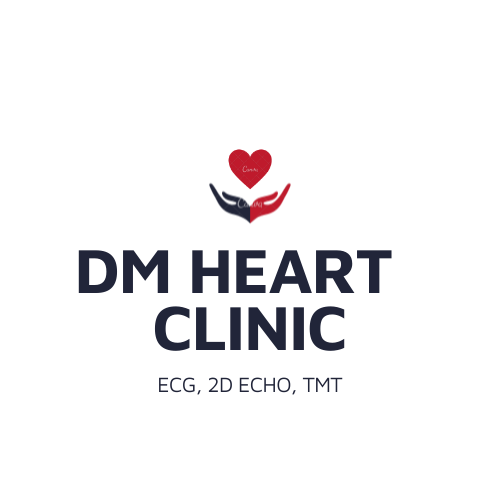

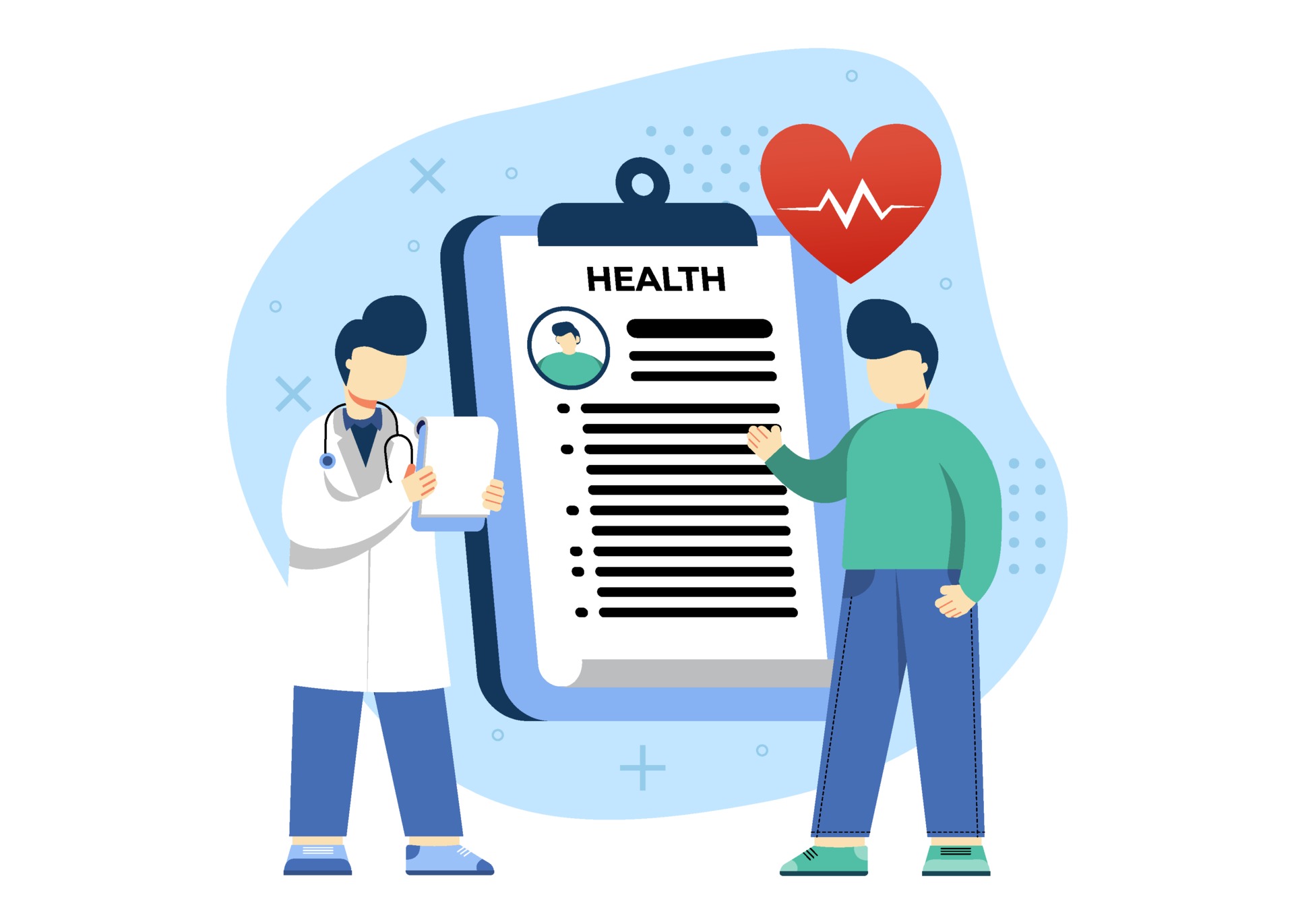
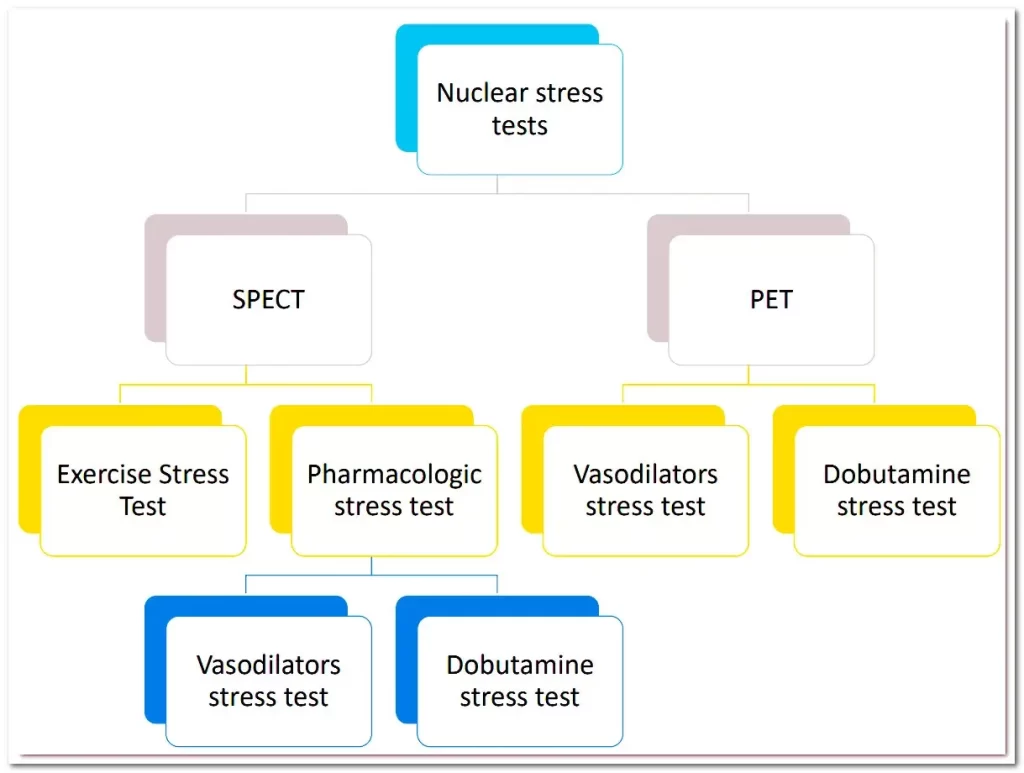





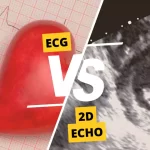

Pingback: What is a 2d echo with a Doppler in Hyderabad ? - DM HEART CARE CLINIC